
PARIS, 1889. The Exposition Universelle was the perfect opportunity to the amaze the world with the power of electricity. Thanks
to its network of gas streetlights, Paris had already been known as the “city of lights” since the beginning of the 1800s, but the
implementation of electric public lighting left the entire globe awestruck.
You will take on the role of one of the city’s most important personalities. The success of your endeavors will be guaranteed by ensuring
that the buildings you build and own are bathed in as much light as possible. Inspire artists and surprise both Parisians and visitors alike
with the beauty and wonder of the city’s new lights!
Contents
Base Game
Eiffel expansion
Promos
First, choose which eight Action cards you will use
to play the game and place them around the board,
face up. For your first few games, we recommend using
those marked with a  ). Place the special pieces
together with their corresponding Action postcards.
Leave the Building pieces to the side, within reach of
both players.
). Place the special pieces
together with their corresponding Action postcards.
Leave the Building pieces to the side, within reach of
both players.
Each player chooses a color (orange or blue) and
takes the 8 cobblestone tiles, 7 chimneys, and 4
Action tokens of their color. Each player shuffles their
Cobblestone tiles and places them face down in a pile.
Then, draw the top tile from your pile and hold it in
your hand so that your opponent cannot see it.
The player who lost the last game of PARIS starts the
game. If it is the first game of the day, the last player
who switched on the lights in any room plays first.
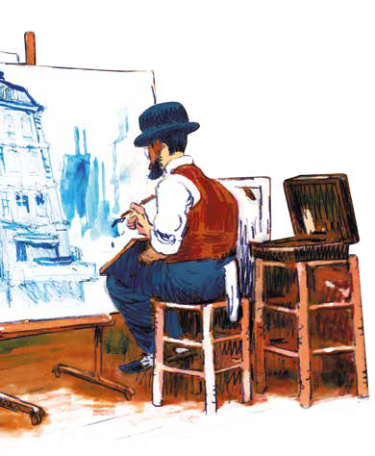
Paris is played over two different phases.
In the first phase, the players take turns placing their
Cobblestone tiles and taking Building pieces.
In the second phase, the players take turns placing their
buildings on the board or carrying out the actions on
the Action postcards, which may grant them advantages
or victory points. Once the two phases have been
completed, the buildings are scored according to their
size and the number of streetlights that shine on them.
Let’s take a look at the phases in greater detail:
Placing of Cobblestone Tiles and Awarding Buildings
The players alternate taking turns. During your turn,
look at the Cobblestone tile you have in your hand
and choose one of these two options:
-
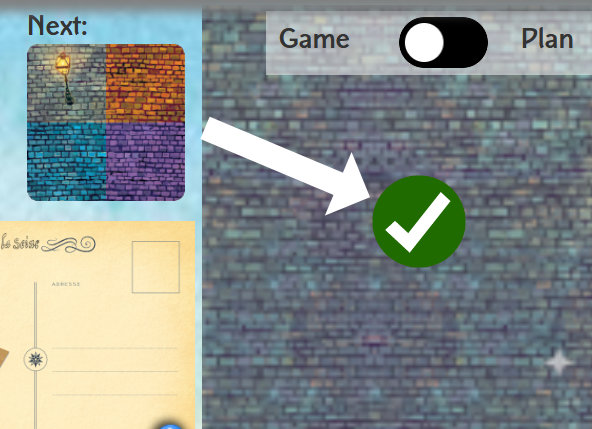 PLACE YOUR COBBLESTONE TILE FACE UP on an empty
square on the board and choose which way it faces.
There are 16 squares on the board. Each Cobblestone tile
must always be placed so that it fully occupies just one
square. After placing the tile, draw the next tile from your
pile and look at it without letting the other player see it.
PLACE YOUR COBBLESTONE TILE FACE UP on an empty
square on the board and choose which way it faces.
There are 16 squares on the board. Each Cobblestone tile
must always be placed so that it fully occupies just one
square. After placing the tile, draw the next tile from your
pile and look at it without letting the other player see it.
-
ADD A BUILDING PIECE TO YOUR RESERVE, by placing
it in front of you. Buildings are taken from the common
pool during this phase, and can then be placed on the
board in the next phase. It is a good idea to have at least 3
or 4 buildings in your reserve before the beginning of the
second phase.

This phase ends when the last of the 16 Cobblestone
tiles is placed on the board. The first player to place all
8 of their tiles can simply pass their turns and wait until
the next phase, or, if they wish, continue taking Building
pieces until the other player has placed all eight of their
Cobblestone tiles.
Place Buildings and Take Actions
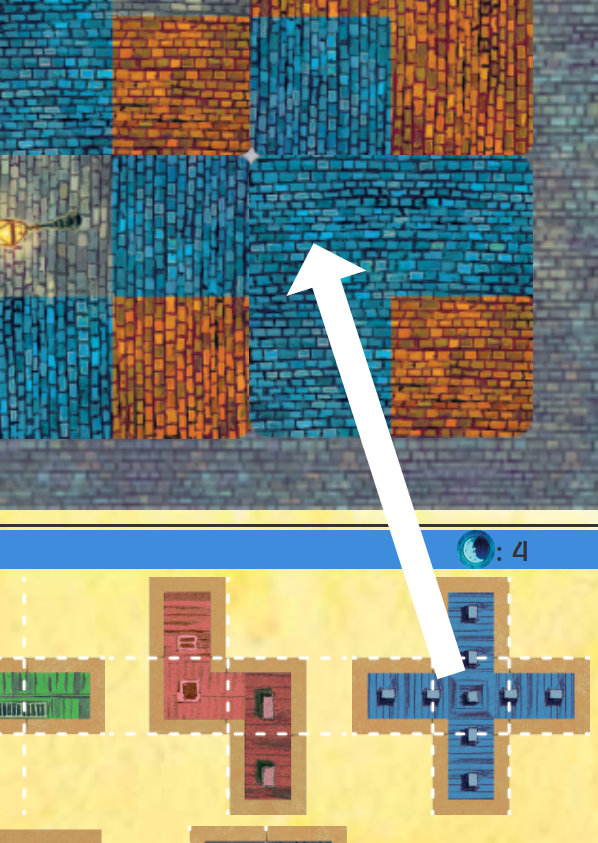
The first player to place all 8 Cobblestone tiles in Phase 1
will take the first turn in the second phase. Once again,
the players alternate taking turns. On your turn you must
choose one of these two options:
-
PLACE ONE OF THE BUILDINGS in your reserve
on the Cobblestone tiles so that it occupies only free
spaces of your color or free mixed-color spaces. Mixed-color
spaces can be occupied by either player. Buildings can
never be placed on Streetlight spaces. When you place a
building on the board, put one of your chimneys on top
of it to show who owns it.
-
ACTIVATE AN ACTION POSTCARD Choose one of the
face-up postcards next to the board. You may use the action
shown on that postcard. Then, flip the card over and place
one of your Action tokens on top of it to show that it has been used.
No one can use this Action postcard again for the rest of the game. See
the last page of this booklet for the specific rules for each
of these actions.
Note: You may activate an Action postcard without
performing its action. This may be a strategic move to
limit your adversary’s options.

The second phase of the game comes to an end when
neither of the players can place any more buildings and all
8 Action tokens have been used.
Once the second phase has been completed, each
player adds up their victory points:
-
Illuminated buildings. Each player multiplies the
size of each of their buildings (the size is the number of
spaces it occupies) by the number of Streetlights that cast
light upon it. Each Streetlight illuminates the four spaces
around it, but not those diagonal to it. Each Streetlight can
illuminate two or more buildings, as long as it is adjacent
to all of them. However, a Streetlight can only be counted
once for each building, even if it lights up more than one
space occupied by that building. A building that is not lit up
by any Streetlights does not award any points.
-
Largest building group. Each player determines
the size of their largest single group of buildings. Buildings
form a group if they are in contact with other buildings
that belong to the same player, with at least one side of
the spaces they occupy touching (diagonal contact does
not count). You score 1 victory point for each space your
largest group of buildings occupies (i.e., the total sum of
all those buildings’ sizes). It does not matter if the Buildings
are illuminated by Streetlights or not.
-
Unbuilt buildings. Each player loses 3 points for
every Building piece that they reserved in the first phase
but were not able to place on the board during the
second phase.
-
 Action postcards. Each player checks
whether any of the Action postcards they marked
with their Action tokens have this stamp. If they do,
those cards grant them additional victory points.
Action postcards. Each player checks
whether any of the Action postcards they marked
with their Action tokens have this stamp. If they do,
those cards grant them additional victory points.
The player who gets the most points is the winner! If
there is a tie, the player with the most visible free spaces
of their color on the Cobblestone tiles wins.
The orange player scores:
-
Illuminated buildings. 6 points for Building A
(1 Streetlight × size 6) + 21 points for Building B
(3 Streetlights × size 7—thanks to the Annex) + 6
points for Building C (3 Streetlights × size 2). Total: 33
points.
-
Largest building group. The size of Buildings
A + B + C. Total: 15 points.
-
Unbuilt buildings. Two buildings were not placed,
which would subtract 6 points. However, the player
has used the Sacré-Coeur. Total: 0 points.
-
Action cards. None are applicable. Total: 0 points.
Grand total: 48 points.
The blue player scores:
-
Illuminated buildings. 10 points for Building D
(2 Streetlights × size 5) + 12 points for Building E
(3 Streetlights × size 4) + 12 points for Building F
(3 Streetlights × size 4) + 9 points for Building G
(3 Streetlights × size 3) + 0 points for Building H
(0 Streetlights × size 3). Total: 43 points.
-
Largest building group. The size of Building
D + E + F. Total: 13 points.
-
Unbuilt buildings. One building was not placed, so
3 points are subtracted. Total: -3 points.
-
Action cards. The blue player gets 4 points for Le
Peintre (I) since 2 Streetlights shine in his area. Total:
4 points.
Grand total: 57 points.
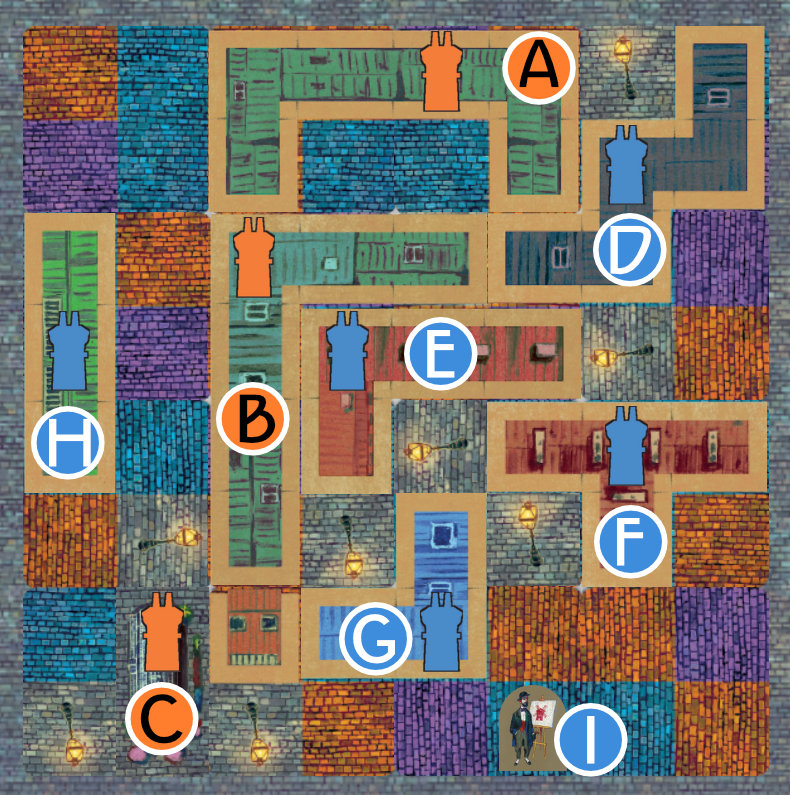
MOULIN ROUGE

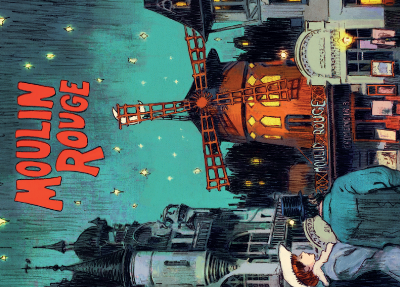
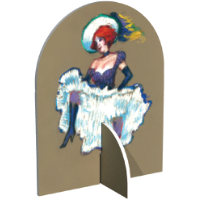
The presence of these famous Parisian
dancers catches the eye of passers-by.
Immediately place the Dancer piece
on the board so that it occupies a
Cobblestone space of your color. At
the end of the game, you will receive
1 additional victory point for each
free Cobblestone space in the area
occupied by the Dancer (the space
she occupies is considered to be free
as well). Her area is defined by the
edges of the board, the buildings,
streetlights, and any other game piece
that covers a Cobblestone space (such
as a Streetlight or the Painter).
FONTAINE DES MERS

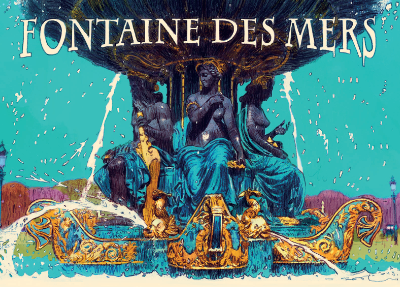
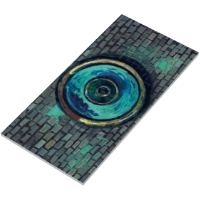
Take the Fountain tile and
immediately place it on a
Cobblestone space of your color or
mixed-colors. At the end of the game,
you get 3 additional points for each
of your buildings that is in contact
with the sides of the Fountain.
LE PENSEUR

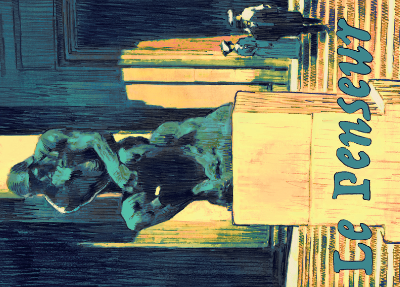
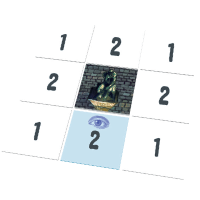
Take the Statue tile and immediately
place it on a Cobblestone space of
your color, leaving at least one other
free space in front of it so that people
can admire it as they go by. At the end
of the game, you get 2 points for each
free Cobblestone space of any color
that touches a side of the Statue and
1 point for each free space of any color
that touches it diagonally. If the space
in front of the statue is occupied, you
receive no points for the Statue.
LA GRANDE LUMIÈRE
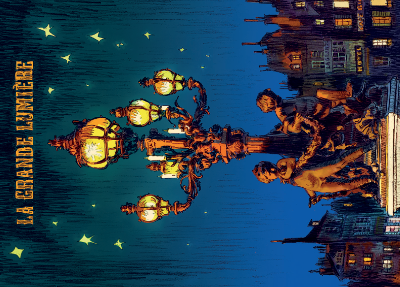
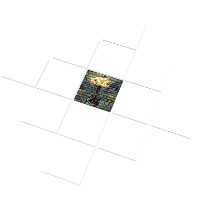
Take the Large Streetlight and
immediately place it on a Streetlight
space. This Streetlight will light up
all the spaces shown on the card.
Buildings block the light from any
other buildings that may be behind
them. Any other pieces do not block
the light.
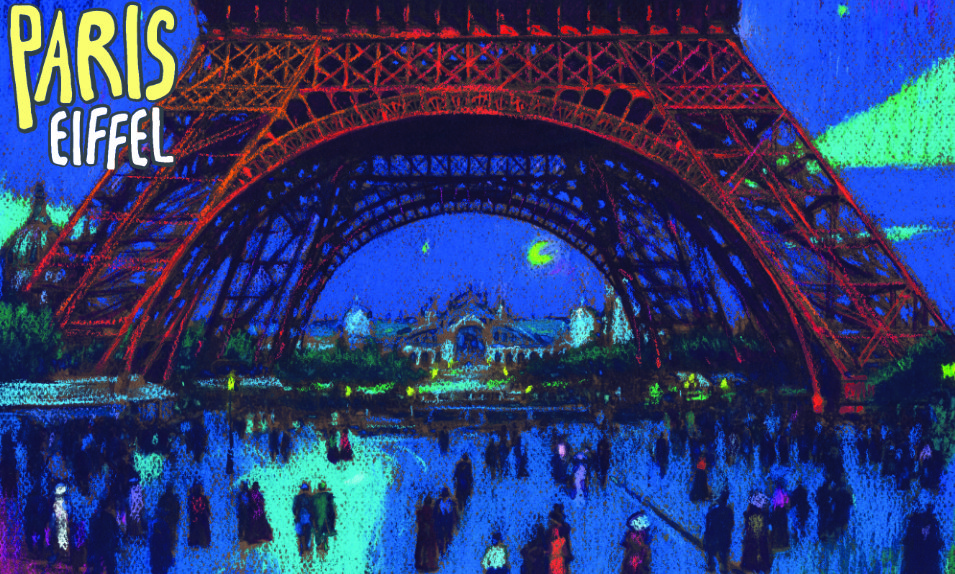
We have been advised that the elevators will still require a few more days before they can enter into service, so it looks like we are going
to be getting a good workout. We will have to climb the stairs to a height of 300 meters to reach the top of this fascinating monster of iron!
Monsieur Eiffel will accompany us on the climb and we are sure to be privy to all kinds of details about the structure, which without any
doubt will be the most impressive of the Universal Exposition that is to be celebrated in our city.
Your humble reporter confesses that he feels quite overwhelmed by this awesome construction. I hope I will be able to muster the courage
to climb to the highest point of the antenna and look over the beauty of Paris and all its wonders.
In this expansion of Paris, you get eight new Action Postcards that you
can mix together and use along with the ones in the base game, and
also a score pad to record the results of your games of Paris.
The Wonders of Paris
OBÉLISQUE DE LOUXOR
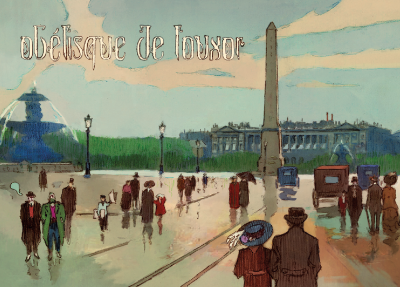
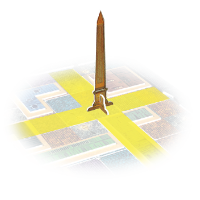
Immediately place the Luxor Obelisk
on a Cobblestone space of your
color. At the end of the game, each
player gets 2 additional points
for each of their buildings that is
located on any space in the same
line (vertically and horizontally) as the
space occupied by the Obelisk.
The Obelisk is not a building.
QUARTIERS PAUVRES
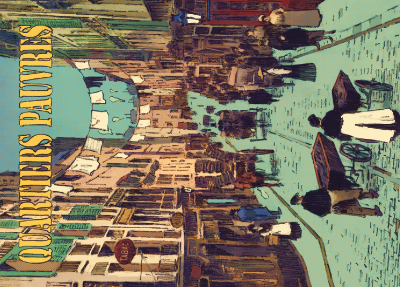

Building beautiful buildings in the least fortunate neighborhoods
will make you popular among the working classes.
At the end of the game, you get additional points based on the
number of different board edges that are in contact with your
buildings: 1, 2, 4, or 8 points if your buildings are in
contact, respectively, with one, two, three, or four
edges of the board.
HÔTEL DES INVALIDES
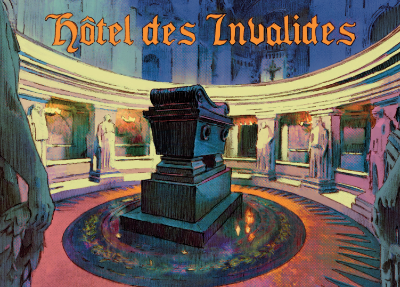
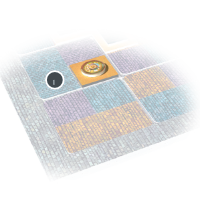
Immediately place the Hôtel
des Invalides on the board on a
Cobblestone space of your color and
place a chimney of your color on top
of it. The Hôtel is scored normally,
and then, at the end of the game,
you get 1 additional point for each
space between this building and
the closest edge of the board.
NOTRE-DAME DE PARIS
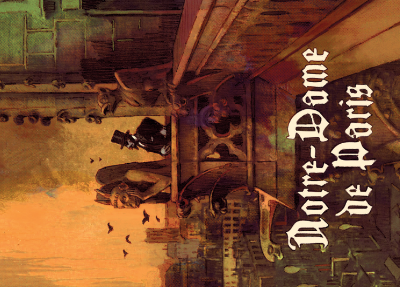

Immediately place the Gargoyle on
a building on the board that belongs
to your opponent. At the end of the
game, your opponent will score
the building normally, and then, in
addition, both players can count it as
their own when determining the size
of their largest building group.
ARC DE TRIOMPHE
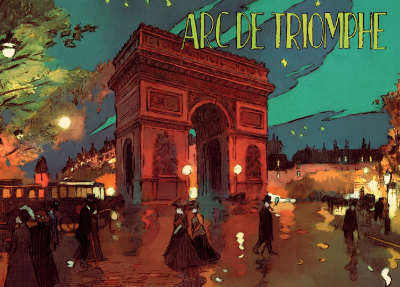
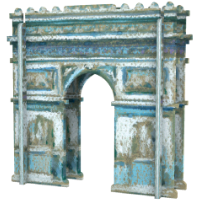
Immediately place the Arc de Triomphe
on the board so that its two ends sit
on Cobblestone spaces of your color.
The central part can occupy spaces
of any type, including Streetlights or
Cobblestones (of any color or mixed).
The Arc de Triomphe is not a building,
so it does not score any points on its
own. But, you do get to count the
spaces it occupies when determining
the size of your largest building group.
TOUR EIFFEL
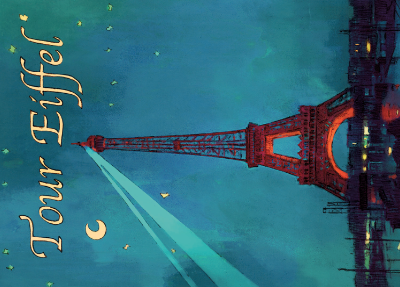
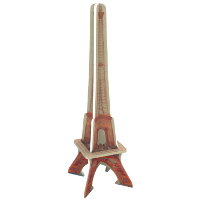
Immediately place the Eiffel Tower on the intersection between four
Cobblestone spaces that are not occupied by any buildings or any
other pieces and that includes at least one Streetlight. Players cannot place
buildings or any other element on any of the four spaces below the Eiffel
Tower. The Eiffel Tower is not a building. The Streetlights under the Eiffel Tower
cross count as double Streetlights. For example: A size 2 building next to one
of these Streetlights scores 4 points instead of the 2 it would normally.
Additionally, at the end of the game, each player gets 2 additional points
for each empty space of their color under the cross of the Eiffel Tower.
For the purposes of other action postcards (such as the “Le Peintre”
or “Moulin Rouge”), the four spaces below the Eiffel Tower are considered
to be occupied.
MUSÉE DU LOUVRE
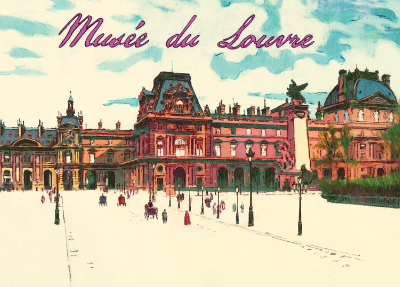
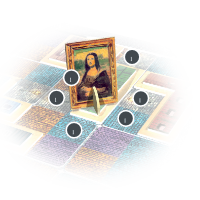
Immediately place the Louvre Museum on one of your buildings on
the board. This building will house the Museum’s exhibit: It will be scored
normally, and then, at the end of the game, you get 1 additional point for
each space orthogonally adjacent to that building that is not occupied
by another building.
CATACOMBES DE PARIS
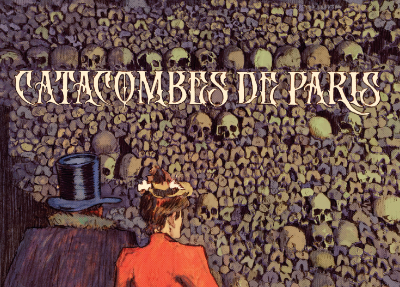

Immediately place the Skull on top of a Cobblestone space of your
opponent’s color (a space that is still available for them to use). If this
space is not occupied by a building when the game ends, simply remove
the Skull before the scoring phase. Otherwise, if your opponent decides
to occupy this space with a building, place the Skull on top of that building
to show that it was built over the Catacombs. At the end of the game,
your opponent will score the building normally, and then, in addition, you
get half as many points as they got for this building (rounding down).
La Seine
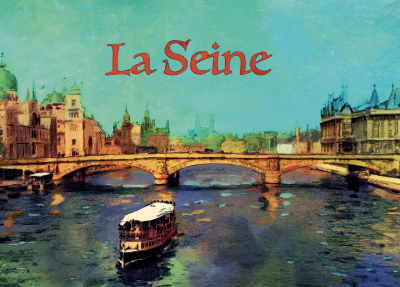
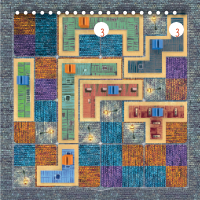
Place this postcard along one side of the board. This side becomes the Seine’s riverbank.
Both players score 3 points for each building they have in contact with that side of the board.
Le Liberté Éclairant le Monde
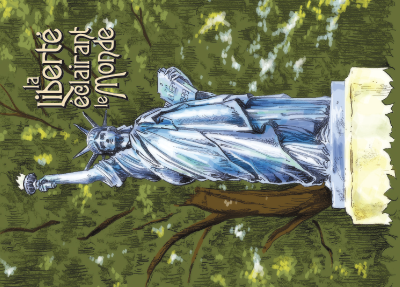
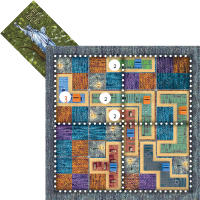
Choose one of the four possible districts, this is where the replica will be located.
Mark your chosen quadrant by placing this postcard in the corner of the district. At
the end of the game, each player will receive 3 points for each of his or her buildings
completely within the chosen district, and 2 points for their buildings partially inside
the district.
Planning

Click this switch to toggle between the current game state and your personal plan. The plan
area is there to help you remember where you are planning to place buildings and postcard pieces.
You can drop buildings and postcard pieces into your planning area. This is a free-form planning area,
the rules of the game are not enforced.

When you are viewing your plan during your turn, you'll see these three buttons:
- Reload: discard all changes made to the plan during this turn and reload the state from the beginning of the turn
- Sync: add all pieces that have been placed in the game to your plan
- Reset: erase your plan and add all pieces that have been placed in the game
Using the planning feature is completely optional and has no effect on the actual game. Your planning area is
private to you and cannot be seen by your opponent. Changes to your plan persist when you click the Finish Turn
button, and you cannot make changes to your plan when it is not your turn.
Unplayed Tiles

In phase 1, you can see the unplayed tiles for each player by clicking on the sun or moon tile back in the top left corner:
Score Display
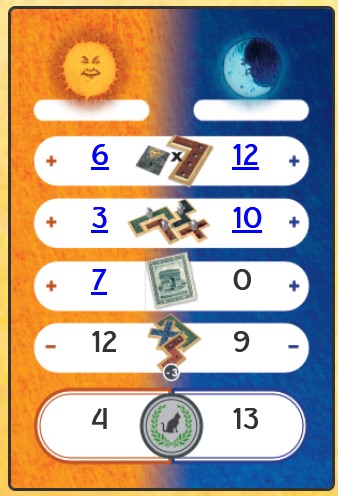
Starting in phase 2, the current score shows in a section near the bottom of the window. You can find an explanation for each
line here. You can click or tap on the blue underlined sections to show which components are
contributing to the total.